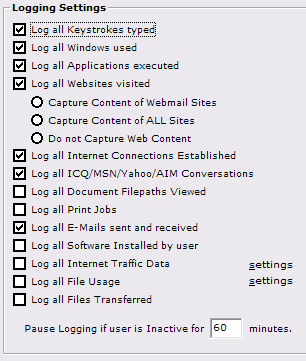|
 Welcome
to NetVizor! Welcome
to NetVizor!

 1.
Getting Started 1.
Getting Started

 2.
Installation 2.
Installation

 3.
Uninstall 3.
Uninstall

The NetVizor Client
 4.
Monitoring 4.
Monitoring

 5.
Viewing Logs 5.
Viewing Logs

 6.
Configuring Logging 6.
Configuring Logging

 7.
General Settings 7.
General Settings

 8.
Advanced Settings 8.
Advanced Settings

 9.
Scheduling 9.
Scheduling

 10.
Content Filtering 10.
Content Filtering

 11.
Stealth Mode 11.
Stealth Mode

 12.
Alert Notifications 12.
Alert Notifications

 13.
Transferring Settings 13.
Transferring Settings

 14.
Report Generation 14.
Report Generation

 15.
IP Security 15.
IP Security

 16.
Security Auditing 16.
Security Auditing

 17.
Roving User Tracking 17.
Roving User Tracking

 18.
Log Searching 18.
Log Searching

 19.
Log Location Config 19.
Log Location Config

 20.
The Web Interface 20.
The Web Interface

 21.
Email Log Delivery 21.
Email Log Delivery

The NetVizor Viewer
 22.
Viewing Users/Computers 22.
Viewing Users/Computers

 23.
Viewer Settings 23.
Viewer Settings

 24.
Computer List Config 24.
Computer List Config

 25.
Network Log Storage 25.
Network Log Storage

 26.
Realtime Activity Ticker 26.
Realtime Activity Ticker

 27.
Visual Network Overview 27.
Visual Network Overview

 28.
Reports Generator 28.
Reports Generator

 29.
Report Delivery 29.
Report Delivery

 30.
Synchronizing Settings 30.
Synchronizing Settings

 31.
Global Filters 31.
Global Filters

 32.
Alerts Manager 32.
Alerts Manager

 33.
How Do I... 33.
How Do I...

 34.
Licensing and Pricing 34.
Licensing and Pricing

 35.
Troubleshooting 35.
Troubleshooting
|
|
Configuring
Logging
 NetVizor's
logging settings can be configured by clicking on the LOGGING button
on the NetVizor's interface. From there you can check what logging
options you want enabled. NetVizor's
logging settings can be configured by clicking on the LOGGING button
on the NetVizor's interface. From there you can check what logging
options you want enabled.
The following logging options can be configured
- Keystrokes typed
This logs all keystrokes typed by users of the machine - including
'special' keystrokes, like backspaces, shift, control, and more.
- Windows viewed
This allows you to log all window titles captured from the windows
users interact with.
- Applications executed
This allows you to record all program activity performed by users.
- Websites visited
This allows you to log all website visits and online searches
performed by users.
NetVizor can log the contents of each website visited for viewing
as well.
- Internet Connections
This logs all incoming and outgoing internet connections.
- Email sent and received (SMTP and POP3)
This logs all incoming and outgoing emails sent and received by
users. Attachments are logged as well.
- Chat Conversations
This logs both sides of chat conversations performed by users.
- Documents viewed (file paths)
This logs all documents and files users open and work with.
- File Usage Activity (creations, deletions, and modifications)
This logs file system creations, modifications, and deletions. This
logging feature can be configured to log file activity on shared
folders if necessary.
- File Transfers
This logs files uploaded and downloaded over the web (HTTP), POP3, SMTP, and
FTP protocols.
- Print Jobs
This logs all print jobs executed by users.
- Software Installs
This logs all software installations performed by users.
- Internet Traffic Data
This logs ALL incoming and outgoing internet data transmitted
and received by users. All email passwords, FTP passwords, website
transmissions, etc, will be logged by this feature.
- Screenshots
This logs visual screenshots of the user activities.
- Total usage time of computer during monitoring sessions
- Events Timeline (programs opened closed, websites visited,
etc.)
- Computer Usage Sessions
NetVizor automatically logs how long a user is active, and idle
during each computer session.
Once you are done configuring your logging settings click "OK"
to save them.
Idle Timeout
NetVizor can be set to pause logging if the user is inactive (or
idle) for a specific amount of time. When the user is once again
active NetVizor will automatically resume logging. This can be configured
under the LOGGING tab as well.
Screenshot Logging
Screenshot logging can be enabled and configured under the "Screenshots"
tab. The Screenshots
logging settings allow you to control how often it captures screenshots,
and whether the entire desktop window (or just the active window)
is captured in the screenshot.
Dual monitors are supported by checking the "This computer uses
dual monitors" option.
Clearing Logs
NetVizor's logs can be manually cleared by using the 'Clear all Logs' menu under
the Activity Logs menu on the NetVizor web interface, or by using the 'Reset'
link within each log in the web-interface.
Remotely Configuring Logging
NetVizor's logging options can be remotely configured via 'Configure Logging'
in the 'Logging Commands' section in NetVizor's web interface. NetVizor's logging
options can also be configured using the NetVizor Viewer's Synchronization feature.
|

 NetVizor's
logging settings can be configured by clicking on the LOGGING button
on the NetVizor's interface. From there you can check what logging
options you want enabled.
NetVizor's
logging settings can be configured by clicking on the LOGGING button
on the NetVizor's interface. From there you can check what logging
options you want enabled.